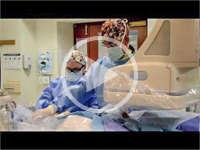Patient Stories
Hearts in Hand: How a Procedure Through the Wrist Can Save Your Life

For many people, a heart attack strikes suddenly and without warning. For others, however, like Sister Geraldine Burns, Sister of Notre Dame and vice principal at Bishop Fenwick High School in Peabody, heart attacks can cause minor symptoms that often go unnoticed.
Sister Burns had been experiencing some shortness of breath after climbing stairs or carrying groceries into her home, but chalked it up to fatigue and a lack of exercise. When the symptoms continued during a trip to Washington, DC, she decided to see a doctor, but still did not expect that her diagnosis would be serious.
“I thought I was feeling poorly because of the heat and all the walking on the trip. I was concerned, but never thought it could be life threatening,” she said.
Soon after her trip, Sister Burns visited NSMC cardiologist, Andrew Kemper, M.D., who performed a stress test. The test suggested that she had a blockage in one of the arteries of her heart, and that she had suffered a minor heart attack during her trip.
“I remember getting the news that I had suffered a heart attack,” said Sister Burns. “I was so surprised because I didn’t think that heart attacks were supposed to happen that way.
Heart attack symptoms differ for women and men. Although most people think of a heart attack as extreme chest pain, many women may instead feel nauseous, achy and weak.
"Unfortunately we see many cases like Sister Burns', said NSMC Chief of Cardiology David Roberts, M.D. "Symptoms can mask themselves as something minor that patients often ignore."
Soon after Sister Burns' diagnosis, Dr. Roberts performed an angiogram, which is an X-ray test that uses a special dye and camera to take pictures of the blood flow in an artery.
During the procedure, Dr. Roberts found the blocked artery and performed an angioplasty by inserting a thin catheter tube into Sister Burns’ radial artery in her wrist and maneuvering it into her heart with X-ray guidance. He then inflated a balloon to open the blockage and inserted two stents so the artery would remain open permanently and blood could continue to flow.
North Shore Medical Center is the only hospital on the North Shore to perform routine radial artery catheterizations in addition to the traditional femoral artery angioplasty approach. Watch a video of Dr. Roberts describing radial cardiac catheterization.
“Radial artery catheterizations have been popular in Europe for 20 years, but are just now becoming more popular in the United States. By entering through a patient’s wrist instead of the groin area, the patient recovers faster, has less pain and there is a much smaller risk of bleeding and major complications,” said Dr. Roberts.
“After the procedure, a patient can stand immediately and may even go home that same day. Patients who undergo a radial artery catheterization require nothing more than a Band-Aid on their wrist.
”Immediately after the procedure Sister Burns felt better. “I felt like a new person. I hadn’t felt that healthy in a year,” she said.
To keep Sister Burns’ heart strong and to help her recover, she has joined NSMC’s Cardiac Rehabilitation Program, which teaches cardiac patients about healthy eating, stress management and how to create and maintain an exercise program.
“I’m learning more about good health everyday,” said Sister Burns, who attends cardiac rehabilitation three times a week. “I’m lucky not only to be alive, but to have a great team of caregivers on the North Shore who saved my life."
"Unfortunately we see many cases like Sister Burns', said NSMC Chief of Cardiology David Roberts, M.D. "Symptoms can mask themselves as something minor that patients often ignore."
Soon after Sister Burns' diagnosis, Dr. Roberts performed an angiogram, which is an X-ray test that uses a special dye and camera to take pictures of the blood flow in an artery.
During the procedure, Dr. Roberts found the blocked artery and performed an angioplasty by inserting a thin catheter tube into Sister Burns’ radial artery in her wrist and maneuvering it into her heart with X-ray guidance. He then inflated a balloon to open the blockage and inserted two stents so the artery would remain open permanently and blood could continue to flow.
North Shore Medical Center is the only hospital on the North Shore to perform routine radial artery catheterizations in addition to the traditional femoral artery angioplasty approach. Watch a video of Dr. Roberts describing radial cardiac catheterization.
“Radial artery catheterizations have been popular in Europe for 20 years, but are just now becoming more popular in the United States. By entering through a patient’s wrist instead of the groin area, the patient recovers faster, has less pain and there is a much smaller risk of bleeding and major complications,” said Dr. Roberts.
“After the procedure, a patient can stand immediately and may even go home that same day. Patients who undergo a radial artery catheterization require nothing more than a Band-Aid on their wrist.
”Immediately after the procedure Sister Burns felt better. “I felt like a new person. I hadn’t felt that healthy in a year,” she said.
To keep Sister Burns’ heart strong and to help her recover, she has joined NSMC’s Cardiac Rehabilitation Program, which teaches cardiac patients about healthy eating, stress management and how to create and maintain an exercise program.
“I’m learning more about good health everyday,” said Sister Burns, who attends cardiac rehabilitation three times a week. “I’m lucky not only to be alive, but to have a great team of caregivers on the North Shore who saved my life."


